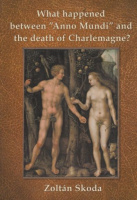categories
- Traffic and Vehicles Catalogue
- socreal.catalog
- Advertisement Catalogue
- Photo Catalogue
- Chinese and Japanese Catalogue
- New Holy Card Catalogue II.
- 12 interesting old books
 Books
Books
 Bibliophil
Bibliophil
 Antiques
Antiques
 Engraving
Engraving
 Maps
Maps
 Photos
Photos
 Antique Papers, Small Prints
Antique Papers, Small Prints
 Posters
Posters
- Circus
- Modern Graphics
- Socialist Realism
- NER Propaganda
- Others
cart
Cart is empty
You've not logged in
Skoda, Zoltán (Hrsg.) : What happend between "Anno Mundi" and the death of Charlemagne? - The new Chronology of the World History from 4713 BCE to CE 1004
- description
- additional information
Since 2002 it has been my firm belief of mine a very significant – almost a 200 year – slip can be detected between the historical and mathematical/astronomical chronology in Antiquity and the Middle Ages in the Mediterranean region and the Near East. Mathematical chronology is based on the movement of the celestial bodies, while historical chronology systematizes the remaining sources on grounds of the data given by different calendar systems. According to the chronology to which I gave the name Hungarian Calendar, Julius Caesar introduced his famous reform calendar named after him the Julian calendar, in the astronomically count-down year of 152 CE. Since then, without any intermission, we measure time in years (365.25 days). This however shortens the today valid time-axis by 196 years. The Hungarian Calendar has determined the date of CE 152 as the starting date of the Julian calendar, by simple astronomical calculations. These calculations essentially count back year by year from the current year’s vernal equinox (the day in Spring with equal day and night) and the result of the “new chronology” are then validated by critical analysis of the historical solar eclipses. I must point out to doubters of this method of counting back in the time that modern astronomical research could not operate without it. A signally important conclusion of the Hungarian Calendar is that the dates of the vernal equinox (spring point) in the starting year of the Julian calendar (152 CE) and at time of the “Augustan correction (208 CE) were both on March 21. The Hungarian Calendar answers the main question: why was it that Pope Gregory, in 1582, amended the calendar (very correctly, by the way) only by 10 days? The Hungarian Calendar also hypothesizes that Jesus Christ was born in 194 CE. After the publication of my Hungarian Calendar (2002, 2004) and my solution for the Seleucid Code (2009) I feel my obligation to answer the questions of the Arabic chronological order which is in frequent use as a proof against the statement of my Hungarian Calendar. In 2004 I published my firm statement in connection with the above important starting date, 1 AH: the year of AD 622 corresponds to the year of 816 CE (Common Era) which is identified astronomically. Or to be more specific: the first day of the AH 1 year corresponds to July 30, 816 CE of Julian calendar! For my research, I used both artificial intelligence and natural unintelligence to edit the book.
| condition: |      |
| category: | Books > Foreign Language Books > Books in English > |
| category: | Books > History > Universal history > |
| category: | Books > Religion > |
| publisher: | Zoltan Skoda, 2023 |
| item number / ISBN: | 0064025 |
| binding: | paperback |
| pages: | 138 p. |
| language: | English |










 Telefon:
Telefon: E-mail:
E-mail:







